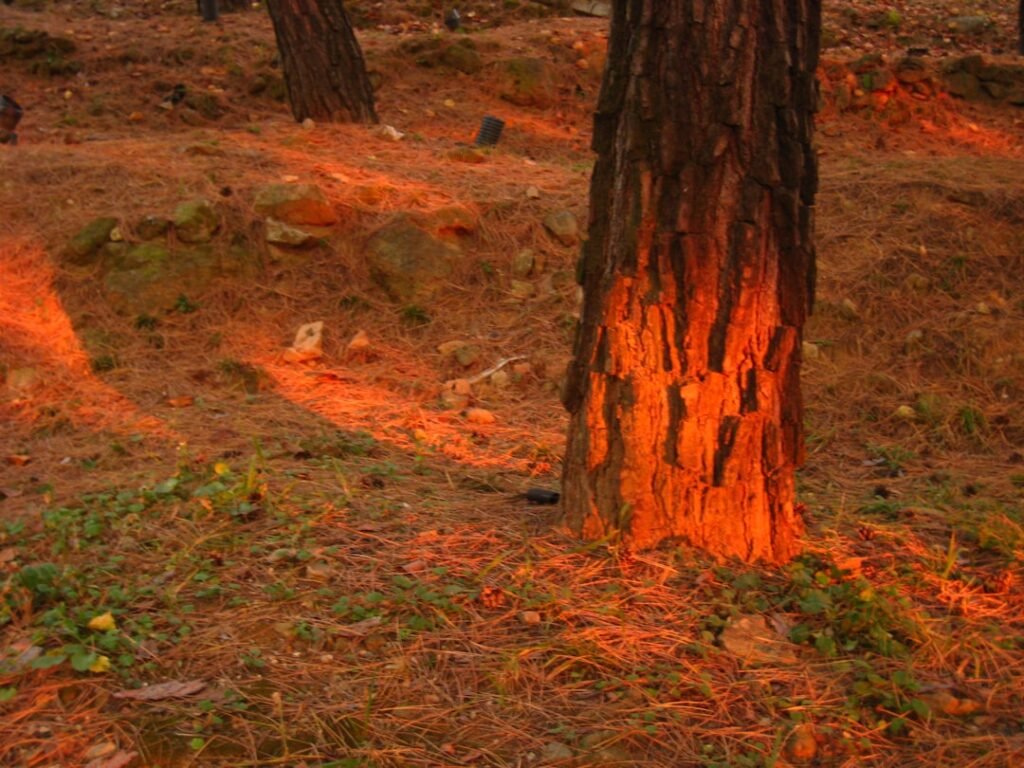Nature constantly surprises us with ingenious adaptations that defy common sense. While most plants flee from fire or perish in its flames, some trees have evolved remarkable strategies not just to survive blazing infernos but to actively embrace them. These extraordinary plants have turned what should be their greatest threat into their most powerful ally for growth and reproduction.
Across fire-prone landscapes from Australia’s scorched forests to California’s burning hillsides, certain trees have developed incredible mechanisms that seem almost supernatural. They store protective buds beneath thick bark, seal their seeds in fire-activated capsules, and even produce flammable oils to encourage the very fires that would destroy their competitors.
Pyrophytes are plants which have adapted to tolerate fire, with some species having evolved to encourage fire through various means. These incredible survivors have mastered the art of living with flames in ways that challenge our basic understanding of plant survival. So let’s dive into this fascinating world where fire isn’t destruction – it’s opportunity.
The Science Behind Fire Adaptation

“Passive pyrophytes” resist the effects of fire, particularly when it passes over quickly, while “Active pyrophytes” contain volatile oils and hence encourage the incidence of fires which are beneficial to them. This remarkable adaptation represents millions of years of evolutionary pressure shaped by recurring wildfires.
Ancient fossils suggest that fire adaptations in plants may have ancient origins, with frequent fires likely exerting evolutionary pressure on flowering plants since the Cretaceous period. The genetic mechanisms behind these adaptations are surprisingly complex, involving multiple pathways that control everything from bark thickness to oil production.
Serotinous Cones: Nature’s Fire-Activated Treasure Chests

Perhaps the most fascinating fire adaptation is serotiny, where trees store their seeds in special cones that remain sealed until fire strikes. The fire-release mechanism is commonly a resin that seals the fruit or cone scales shut, but which melts when heated. These biological time capsules can remain closed for decades, patiently waiting for the right moment.
Seeds may be retained in the tree canopy for between 3 and 50 years until the heat of a fire acts to break the resin bonds holding the cone scales closed, simultaneously releasing seeds into the environment. Lodgepole pines are master practitioners of this strategy, creating dense forests that can seem almost explosive when fire finally arrives. These “serotinous” cones can hang on a pine tree for years, long after the enclosed seeds mature, and only when a fire sweeps through, melting the resin, do these heat-dependent cones open up, releasing seeds.
The timing couldn’t be more perfect. Fire clears away competing vegetation and creates nutrient-rich ash beds, giving the newly released seeds the ideal conditions for germination and growth.
Epicormic Buds: The Hidden Army Beneath the Bark

Underneath the bark of a normal-looking eucalypt lie thousands of dormant buds. These invisible “epicormic” buds are a remarkable adaptation, letting the tree rapidly regrow after bushfires. Think of them as a tree’s secret emergency response team, waiting in the wings for their moment to shine.
These epicormic buds are highly protected, set deeper beneath the thick bark than in other tree species, allowing both the buds and vascular cambium to be insulated from the intense heat. When fire destroys the canopy, these hidden buds spring into action with remarkable speed. Epicormic shoots can grow remarkably quickly, with some capable of rapid growth rates following fire events.
The sight of these “toothbrush trees” emerging from fire-blackened trunks is one of nature’s most hopeful spectacles. Within months, what appeared to be a devastated forest transforms into a vibrant green landscape, proof of these trees’ incredible resilience.
Thick Bark: The Ultimate Fire Shield

Trees in fire-prone areas develop thicker bark, in part, because thick bark does not catch fire or burn easily. It also protects the inside of the trunk, the living tissues that transport water and nutrients, from heat damage during high-frequency, low-intensity fires. This natural armor can be surprisingly effective, with some species developing bark several inches thick.
Certain trees, including larches and giant sequoias, have incredibly thick, fire retardant bark and can be directly burned without sustaining damage to their vital tissues. Ponderosa pines showcase this adaptation beautifully, with their distinctive plated bark that can withstand repeated low-intensity burns throughout their long lives.
The effectiveness of thick bark depends heavily on fire intensity. While it provides excellent protection against surface fires, crown fires can still overwhelm even the most well-armored trees.
Underground Storage Systems: The Root of Survival

Many fire-adapted trees invest heavily in underground storage structures that serve as their ultimate backup plan. Lignotubers are swellings that develop at ground level where food is stored, allowing new growth to sprout if the tree is damaged. Lignotubers contain a mass of hidden buds that rapidly grow new shoots when the seedling, sapling or tree is damaged by fire.
To appreciate the complexity of a lignotuber, imagine the trunk of a eucalypt with all its epicormic buds scrunched into a ball at the base of the trunk. The buds have direct access to a large root system able to supply water, nutrients and carbohydrates. This underground fortress ensures that even if everything above ground is destroyed, the tree can rebuild itself from scratch.
These remarkable structures can remain dormant for years, only activating when fire or other severe damage triggers their growth response. They represent one of evolution’s most clever insurance policies.
Active Fire Promotion: Trees That Play With Matches

Some of the most extraordinary fire-adapted trees don’t just survive fire – they actively encourage it. Some trees and shrubs such as the Eucalyptus of Australia actually encourage the spread of fires by producing flammable oils, and are dependent on their resistance to the fire which keeps other species of tree from invading their habitat.
Certain active pyrophytes, such as some eucalyptus species and gum trees, produce flammable oils to encourage the fires, having specialized buds under their thick bark once the old branches and competing flora are burned. This might seem suicidal, but it’s actually brilliant strategy. By promoting fires, these trees eliminate competition from fire-sensitive species while relying on their own superior fire resistance to survive and thrive.
The oils produced by these trees don’t just burn – they burn hot and fast, creating the perfect conditions for opening serotinous cones and clearing understory vegetation. It’s ecological warfare at its most sophisticated.
Post-Fire Growth Advantages

While most plants succumb to the flames, pyrophytes not only survive, but can take advantage of post-fire conditions thanks to the fertility of the ashes and less competition for resources. The aftermath of fire creates a unique ecological window of opportunity that fire-adapted trees are perfectly positioned to exploit.
When a fire moves through an area, it removes older and decaying vegetation, which gives the new plants more room . It may cause damage to the parent plant, but the new shoots can take advantage of the nutrients in the soil after a burn. Fire essentially acts as a massive fertilizer and weed control system combined into one powerful ecological force.
The reduced competition means that fire-adapted trees can access sunlight, water, and nutrients that were previously monopolized by dense vegetation. This competitive advantage often leads to explosive growth rates in the years immediately following a fire.
Climate Change and Future Challenges

The adaptation of pyrophyte species is closely linked to the stability of the fire regime. Climate change and inadequate forest management are altering these patterns, with more intense, unpredictable and frequent fires, which poses a challenge to the biodiversity and survival of both plants and fire-adapted animals.
Even the most fire-resistant trees face new challenges as climate change alters fire patterns worldwide. If fires are too frequent, there is insufficient time to accumulate the next crop of seeds. Conversely, if fires are not frequent or intense enough, seeds will not be released often enough.
Some species such as mountain ash are not coping with pressures such as logging and climate change, while some alpine species like snow gums face challenges adapting to altered fire patterns. The delicate balance between fire frequency, intensity, and timing that these trees evolved with over millions of years is being disrupted faster than they can adapt.
These remarkable trees have mastered the art of turning destruction into opportunity, showing us that survival often requires embracing what others fear most. Their strategies remind us that nature’s solutions are often far more creative and counterintuitive than we might imagine. As we face an uncertain climate future, understanding these fire-adapted champions becomes more crucial than ever. What other “impossible” adaptations might nature have in store for us to discover?




